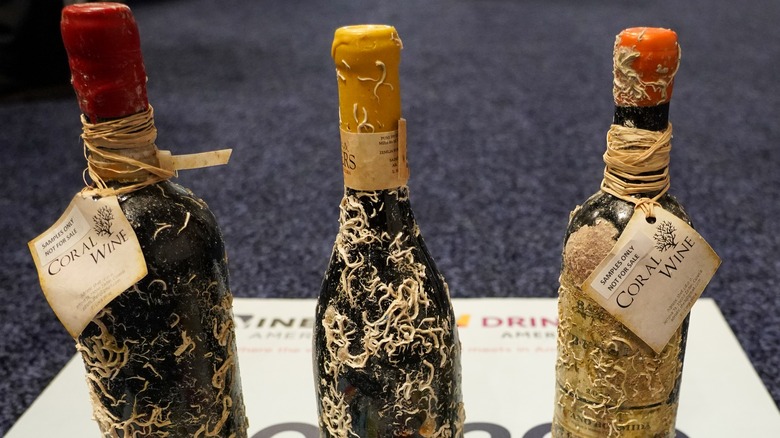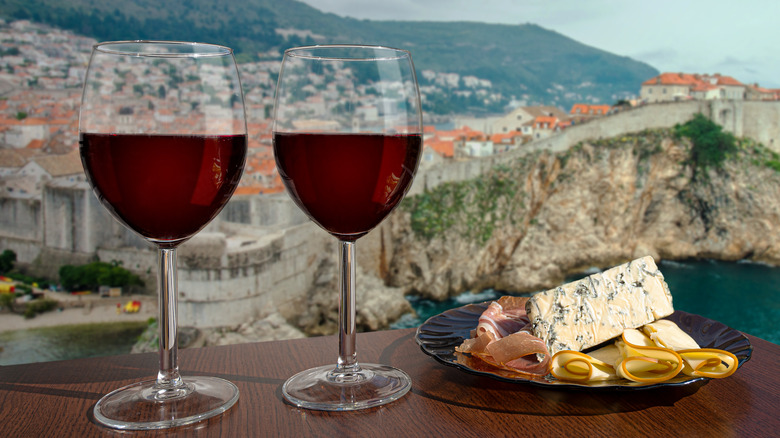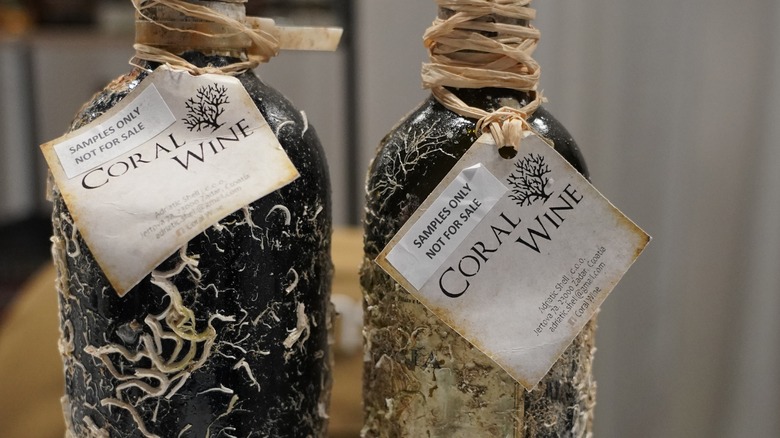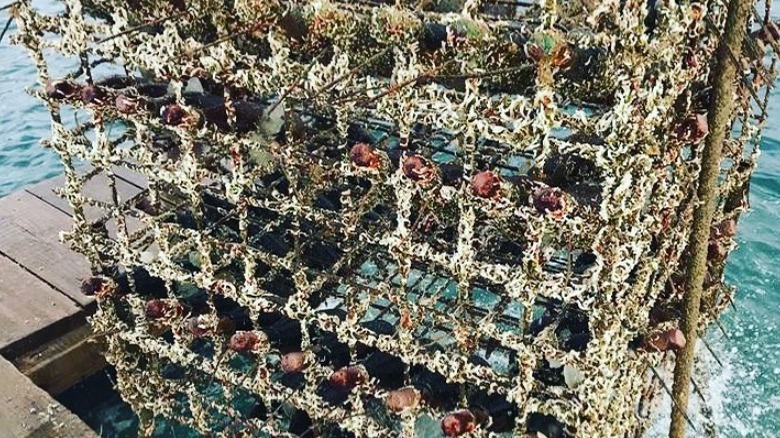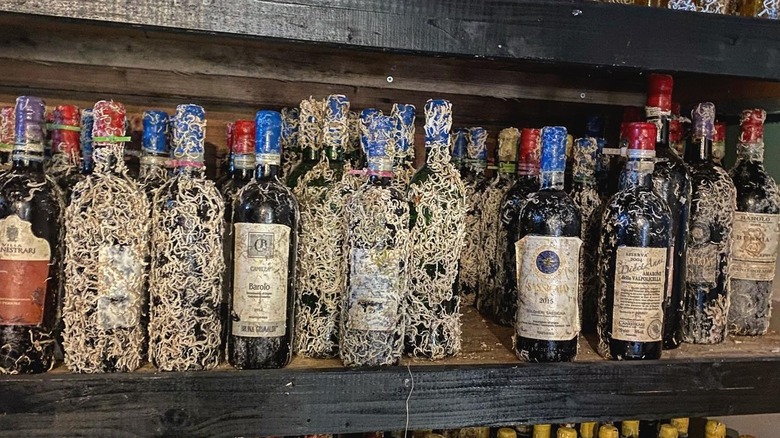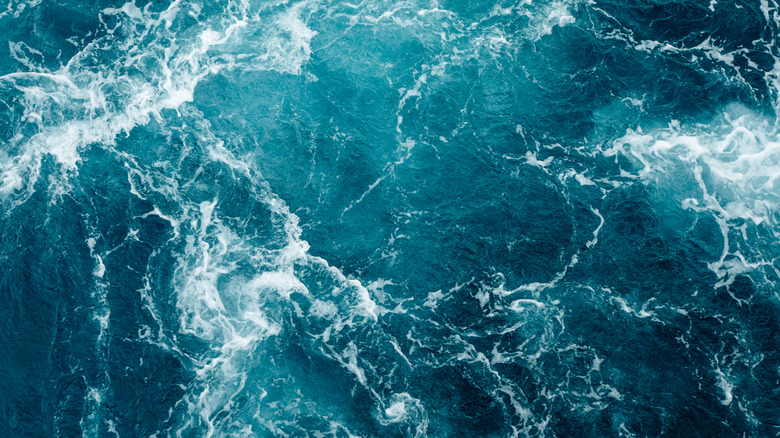Croatia's Unique Coral Wine Is Aged Under The Sea
Winemaking is as mystifying as it is scientific. So much more goes into making our favorite vintages than simply crushing grapes and turning the juice into alcohol. However, the most intriguing of all the steps taken from vine to glass is aging. Also known as cellaring, aging wine is a delicate process during which acids, alcohol, temperature, humidity, and air pressure all work together to develop, evolve, and change the nature of the liquid in the bottle (via Wine Enthusiast).
Perhaps the most important component of aging wine is to keep it in the correct environment. Ideal aging conditions include stable temperatures and lack of sunlight. As the cellaring name suggests, underground wine cellars match these criteria perfectly. However, a cellar is not the only place where one can age wine. There is an alternative that has been tested out in Eastern Europe to enthusiastic results: aging wine in the sea.
The Balkan nation of Croatia was the first country in the world to age wine in the ocean. The idea, formulated by an eccentric entrepreneur, was to see how wines would develop when met with the vastly different atmosphere provided by the ocean. This coastal cellaring project has intrigued wine experts from across Europe looking to see just how different coral wine could be from anything else on the market, per Wine and More.
History of wine in Croatia
Before we dive in (pun intended) after these special bottles of wine, we should stop and understand a bit about wine's history in Croatia. You could be forgiven for not knowing that Croatia even produced wine. With the likes of France, Italy, and Spain to contend with, it's no wonder that this small country in Europe's oft-forgotten east is looked over. However, that makes it something of a hidden gem.
According to Armchair Sommelier, wine has been produced in Croatia for thousands of years. From invading conquests during the Middle Ages to Soviet Block communism, Croatia has never been without some sort of wine industry. As a near twin of its Adriatic neighbor Italy, Croatia has a unique variety of coastal, uplands, and mountainous terroir highly suitable for winemaking.
Thanks to this biodiversity, several different varieties of grapes, both native and international, can thrive in Croatia. Some notable native wines include the bold red wine of the Dalmatia region Plavac Mali, its almond-flavored white companion Pošip, and the peppery Grk of the central islands. Other areas in the country produce internationally recognized varieties such as Cabernet Sauvignon, Chardonnay, Merlot, Riesling, and Grasevina (via Wine Folly). It is this heritage that has led to Croatia's status as a producer of quality wines and influenced the creation of the Coral Wine Project.
The Coral Wine project
The Coral Wine Project (CWP) was developed by Croatian wine enthusiast and entrepreneur Marko Dušević, who owns and operates a mussel and oyster farm on the island of Pag in the Adriatic. While the CWP does not produce its own wine, it specializes in aging wines in the clear, cool waters of Croatia's coast. It was the world's first underwater wine cellar. Dušević gathered around himself several different wineries and wine experts to begin the project in 2013. Four years later, in 2017, the first bottle of coral wine was officially released for commercial sale (via The Vintner Project).
According to Wine and More, CWP wines are stored in crates submerged 15 to 30 meters, roughly 50 to 100 feet, below the sea. The temperature range at that depth varies between 8 to 16 degrees Celsius (46 to 60 degrees Fahrenheit). The wines are kept at this depth for a number of months. The environment is devoid of sunlight, and energy is gently imparted to the wine through currents and underwater springs.
The project has been a resounding success. As The Taste of Croatia reports, in its near decade of existence, the CWP has maintained a yearly production of over 15,000 bottles of wine from 500 different labels, 150 different winemakers, and 15 European countries.
Benefits of underwater aging
Wine has had a close relationship with the sea for thousands of years. Ancient Greeks used to mix seawater into wine both as a method of preservation and flavor enhancer, per Greek Reporter. The saltwater would mix with the wine's sweetness to create a more balanced palate. With coral wine, however, the bottles are specifically sealed against any seawater penetration. How, then, does the sea affect the wine's flavor?
According to Food and Wine, when compared to their cellar-aged counterparts, wine aged underwater had more amplified and elegant flavors. The wine's maturity was particularly noticeable after only a short time beneath the waves. The theory behind this is that the barometric pressure placed on the wine bottles at significant depths will achieve in one year what it takes a cellar three years to achieve.
For the Coral Wine Project, Marko Dušević, quoted in Wine and More, states that wines aged underwater have very clear character differences in flavor, color, and aroma. Numerous tests of coral wine have proven the theory of accelerated aging to be correct. Wines of the CWP have an age rate three to five times faster than traditional wine. Yet, the key elements of the wine are enhanced instead of muddled. Aging under the sea offers the qualities found in a traditionally aged terrestrial wine in half the time and with better flavors.
Bottle art
Though the emphasis should always be on the wine inside, it's impossible not to notice the amazing and funky encrustation on a bottle of coral wine. The process behind this fascinating mottling can be explained, funnily enough, through reef conservation efforts. Glass is a common material used in coral reef restoration owing to its light weight and small footprint. By placing bottles at strategic points in the sea, coral is encouraged to cling and grow on the glass. This is an excellent use of bottle waste and goes a long way toward restoring the ocean's natural filters (via Conservation Diver).
Coral wines are typically held underwater for anywhere from 200 to 750 days. As they are typically kept in a current or near an underwater spring, algae and other organic marine organisms will travel past the bottles and eventually cling to the glass surface. The specially designed cages the wine bottles sit in encourage this process (via Wine and More).
The bottles come out of the water looking like they've been recovered from some ancient shipwreck. They're covered in barnacles, coral, and seaweed. Each bottle can be viewed as an individual work of art and a unique conjunction between a man-made product and the natural world, per The Taste of Croatia.
Types of coral wine
There is no real definitive type of coral wine. As underwater wine is a process rather than a variety, virtually any type of wine can become coral wine. Erdevik Estate of Serbia has worked with the CWP to develop a special wine called the Grand Trianon Deux Mers. The Deux Mers is a dry red wine blend composed of Cabernet Sauvignon, Shiraz, and Merlot, that has been aged for eight months in the Adriatic Sea. According to the Estate, the soil composition of their winery, which includes a bed layer of fossilized coral and shells, dictates the rich, earthy flavors of the finished wine. These flavors are then amplified by the time spent beneath the water.
A point of pride for Croatia is Evido Vina, which was the first winery to age native Croatian wines in their home sea. They chose the classic Plavac Mali, determining that it had the right flavors and composition to stand upwards of 2 years underwater. The resulting wine was called Navis Mysterium or Secrets of the Sea. It was sold specifically as a luxury item owing to the added cost of aging wine underwater — which doesn't exactly come cheap (via Wheel and Anchor).
While wineries across the world have jumped on the trend of sinking their beloved product beneath the waves, per Food52, the coral wine of Croatia seems to have a special quality that will keep it unique and desirable for years to come.
